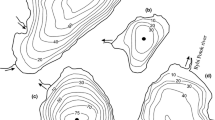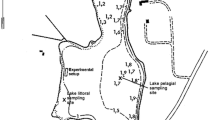Abstract
In 1990 an experiment started in the large and shallow lake Wolderwijd (2700 ha, mean depth 1.5 m) to improve the water quality. About 75% of the fish stock was removed (425 000 kg fish). The fish was mainly composed of bream and roach. In May 600000 young pikes (3–4 cm) were introduced.
In May 1991 the water became very clear (Secchi depth 1.8 m) during a spring bloom of large Daphnia. Then the grazing by zooplankton was eight times higher than the primary production of algae and the total suspended matter concentration became very low. Compared to the situation before the fish reduction, the grazing had increased only slightly, while the primary production had decreased significantly in early spring. The fish stock reduction might have contributed to the reduction in primary production by a reduced internal nutrient load. The clear water period lasted six weeks. Daphnia disappeared in July due to food limitation, the algal biomass increased and the Secchi depth became 50 cm. Daphnia did not recover during summer, due to predation that was not caused by 0 + fish but by the mysid shrimp Neomysis integer. Neomysis could develop abundantly, because of the reduced biomass of the predator perch. The production of young fish had been low because of the cold spring weather. The cold weather was probably also responsible for the slow increase in density of macrophytes. After 1991, perch probably can control Neomysis. Due to lack of spawning places and shelter for 0 + pike, pike was probably not able to control the production of 0 + fish. In a lake of this scale, it will not be easy to get more than 50% coverage of macrophytes, which seems necessary to keep the algal biomass low by nutrient competition. Therefore, we expect also in the future a decrease in transparency in the summer. Locally, especially near Characeae, the water might stay clear.
Similar content being viewed by others
References
Andersson, G., H. Berggren, G. Cronberg & C. Gelin, 1978. Effects of planktivorous and benthivorous fish on organisms and water chemistry in eutrophic lakes. Hydrobiologia 59: 9–15.
Backx, J. J. G. M. & M. P. Grimm, in press. Mass-removal of fish from lake Wolderwijd (2700 ha), The Netherlands. Part II: results of the fishing. Contribution to ‘The international seminar on mass removal of (unwanted) fish in large inland waters. June 10–12, 1991, Lahti, Finland’ (in press).
Bottrell, H. H., A. Duncan, Z. M. Gliwicz, E. Grygierek, A. Herzig, A. HillbrichtIlkowska, H. Kurasawa, P. Larsson & T. Weglenska, 1976. A review of some problems in zooplankton production studies. Norw. J. Zool. 24: 419–456.
Bremer, P. & J. Vijverberg, 1982. Production population biology and diet of Neomysis integer (Leach) in a shallow Frisian lake (The Netherlands). Hydrobiologia 93/Dev. Hydrobiol. 10: 41–51.
Breukelaar, A. W., 1992. Impact of benthivorous fish on water quality. RIZA nota 92.038 (in Dutch).
DeMelo, R., R. France & D. J. McQueen, 1992. Biomanipulation, Hit or Myth? Limnol. Oceanogr. 37: 192–207.
Grimm, M. P. & J. J. G. M. Backx, 1990. The restoration of shallow eutrophic lakes and the role of northern pike, aquatic vegetation and nutrient concentration. Hydrobiologia 200–201/Dev. Hydrobiol. 61: 557–566.
Grimm, M. P., E. Jagtman & M. Klinge, 1992. P-concentration and the feasibility of biomanipulation. A fish biological perspective. H2O 16: 424–431 (in Dutch).
Grimm, M. P. & J. J. G. M. Backx, in press. Mass-removal of fish from lake Wolderwijd (2700 ha), The Netherlands. Part I: planning and strategy of a large scaled biomanipulation project. Contribution to ‘The international seminar on mass removal of (unwanted) fish in large inland waters. June 10–12, 1991, Lahti, Finland’ (in press).
Gulati, R. D., 1990. Structural and grazing response of zooplankton community to biomanipulation in Dutch water bodies. Hydrobiologia 200–201/Dev. Hydrobiol. 61: 99–118.
Gulati, R. D., A. Doornekamp, W. A. De Kloet & K. Siewertsen, 1992. Phytoplankton production and zooplankton and its grazing in the Lake Wolderwijd after its biomanipulation: 1991, the first year. Internal Report 1992–1, The Netherlands Institute of Ecology, Centre for Limnology, Nieuwersluis.
Gulati, R. D., K. Siewertsen & G. Postma, 1982. The zooplankton: its communits structure, food and feeding, and role in the ecosystem of lake Vechten. Hydrobiologia 95/Dev. Hydrobiol. 11: 127–163.
Hosper, S. H. & E. Jagtman, 1990. Biomanipulation additional to nutrient control for restoration of shallow lakes in The Netherlands. Hydrobiologia 200–201/Dev. Hydrobiol. 61: 523–534.
Huisman, E. A., 1974. Optimalisation of the growth of carp (Cyprinus carpio). Ph.D. Thesis University Wageningen, 95 pp (in Dutch).
Jansen, W. & R. Heerkloos, 1983. The role of Neomysis integer (leach) in conversion of matter in the eutrophic brackish Barther Bodden. 1. Consumption of phytoplankton. Wiss. Zeitschrift der Wilhelm-Pieck Universitat, Rostock 32: 39–47. (in German).
Lamarra, V., 1975. Digestive activities of carp as a major contributor to the nutrient loading of lakes. Verh. int. Ver. Limnol. 19: 2461–2468.
Lammens, E. H. R. R. & B. Vlink, 1990. Foodcomposition, condition, abundance and recruitment of the dominant fish species in lake Wolderwijd in summer 1990. Limnol. Instit. Nieuwersluis, The Netherlands. Report 1990–2 (in Dutch).
Meijer, M-L., M. W. de Haan, A. W. Breukelaar & H. Buitenveld, 1990. Is reduction of the benthivorous fish an important cause of high transparency following biomanipulation in shallow lakes? Hydrobiologia 200–201/Dev. Hydrobiol. 61: 303–315.
Meijer, M-L., E. Jeppesen, E. van Donk, B. Moss, M. Scheffer, E. H. R. R. Lammens, E. H. van Nes, J. A. van Berkum, G. I. de Jong, B. Faafeng & J. P. Jensen, 1994. Longterm responses to fish-stock reduction in small shallow lakes: interpretation of five year results of four biomanipulation cases in The Netherlands and Denmark. Hydrobiologia 275–276/Dev. Hydrobiol. 94: 457–466.
Mooy, W. M. & O. F. R. van Tongeren, 1990. The growth of roach (Rutilus rutilus) in relation to temperature and size in a shallow eutrophic lake: comparison of field data and laboratorium observations. Can. J. Fish. aquat. Sci. 47: 960–967.
Moss, B., 1990. Engineering and biological approaches to the restoration from eutrophication of shallow lakes in which aquatic plant communities are important components. Hydrobiologia 200–201/Dev. Hydrobiol. 61: 367–377.
Moss, B., 1994. Brackish and freshwater shallow lakes — different systems or variations on the same theme? Hydrobiologia 275–276/Dev. Hydrobiol. 94: 1–14.
Ozimek, T., R. D. Gulati & E. van Donk, 1990. Can macrophytes be useful in biomanipulation of lakes. The lake Zwemlust example. Hydrobiologia 200–201/Dev. Hydrobiol. 61: 399–408.
Reinertsen, H. & Y. Olsen, 1984. Effects of fish elimination on the phytoplankton community of an eutrophic lake. Verh. int. Ver. Limnol. 22: 649–657.
Sondergaard, M., E. Jeppesen, E. Mortensen, E. Dall, P. Kristensen & O. Sortjaer, 1990. Phytoplankton biomass reduction after planktivorous fish reduction in a shallow eutrophic lake: a combined effect of reduced internal P-loading and increased zooplankton grazing. Hydrobiologia 200–201/Dev. Hydrobiol. 61: 229–240.
Taylor, B., 1985. Effect of food limitation on growth and reproduction of Daphnia. Arch. Hydrobiol. Beih. Ergebn. Limnol. 21: 285–296.
Threlkeld, S. T., 1994. Benthic-pelagic interactions in shallow water columns: an experimentalist's perspective. Hydrobiologia 275–276/Dev. Hydrobiol. 94: 293–300.
Van Densen, W. L. T.,1985. Feeding behaviour of major 0 + fishes in a shallow, eutrophic lake (Tjeukemeer, The Netherlands). J. appl. Ichthyol.: 141–165.
Van Donk, E., M. P. Grimm, R. D. Gulati & J. P. G. Klein Breteler, 1990a. Whole-lake food-web manipulation as a means to study community interactions in a small ecosystem. Hydrobiologia 200–201/Dev. Hydrobiol. 61: 275–289.
Van Donk, E., M. P. Grimm. R. D. Gulati, P. G. M. Heuts, W. A. De Kloet & E. Van Liere, 1990b. First attempt to apply whole-lake food-web manipulation on a large scale in The Netherlands. Hydrobiologia 200–201/Dev. Hydrobiol. 61: 291–302.
Van Donk, E., R. D. Gulati, A. Iedema & J. T. Meulemans, 1992. Macrophyte-related shifts in nitrogen and phosphorus contents of the different trophic levels in a biomanipulated shallow lake. Hydrobiologia (accepted).
Van Liere, E. & R. D. Gulati, 1992. Restoration and recovery of shallow eutrophic lake ecosystems in The Netherlands: epilogue. Hydrobiologia 233/Dev. Hydrobiol. 74: 283–287.
Van Liere, E., L. Van Ballegooijen, W. A. De Kloet, K. Siewertsen, P. Kouwenhoven & T. Aldenberg, 1986. Primary production in the various parts of the Loosdrecht lakes. Hydrobiol. Bull. 20: 77–85.
Vanni, M. J. & D. L. Findlay, 1990. Trophic cascades and phytoplankton community structure. Ecology 71: 921–937.
Vijverberg, J., 1982. Effects of temperature in laboratory studies on development and growth of Cladocera and Copepoda from Tjeukemeer, The Netherlands. Freshwat. Biol. 10: 317–340.
Winberg, G. G., 1956. Rate of metabolism and food requirements of fishes. Fish. Res. Board Transl. Ser. 194: 1–202.
Winberg, G. G., 1971. Symbols, units and conversion factors in studies of freshwater productivity. I.B.P. Central Office, London, 23 pp.
Author information
Authors and Affiliations
Rights and permissions
About this article
Cite this article
Meijer, M.L., van Nes, E.H., Lammens, E.H.R.R. et al. The consequences of a drastic fish stock reduction in the large and shallow Lake Wolderwijd, The Netherlands. Can we understand what happened?. Hydrobiologia 275, 31–42 (1994). https://doi.org/10.1007/BF00026697
Issue Date:
DOI: https://doi.org/10.1007/BF00026697




